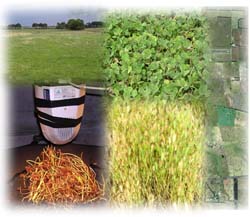Mapping soil salinity using satellite imagery
Hyperspectral Mapping Results
In contrast, hyperspectral sensors with over 100 spectral bands have a much greater ability to differentiate vegetation down to genera and in some cases species level. The Australian designed HymapTM sensor has 126 bands in the region between 450 nm to 2500 nm width band width varying between 15 and 20 nm and 3 metre pixels. These sensors have the potential to significantly reduce the cost of mapping and monitoring the extent and severity of soil salinity based on the presence of salt tolerant species while maintaining the accuracy of the current field based method.
The National Action Plan (NAP) (external link) funded a project to investigate whether it was possible to discriminate between salt-tolerant species from salt-sensitive based on their reflectance spectra. A handheld spectrometer was used to measure reflectance in the visible and near-infrared part of the spectrum. Plant samples from around 16 species were collected three times through the summer and taken back to a laboratory where reflectance measurements were made under controlled lighting. Results were promising with the ability to correctly identify the target species ranging from 88% to 95%.
DPIs Agriculture Division and DSE have co-funded a project to investigate whether this approach could be scaled up to data collected from an airborne hyperspctral scanner – using HymapTM data that was collected over salt affected sites on the basalt plains east of Hamilton. Attenuation of reflectance by the atmosphere and the effect of mixed species within each pixel can adversely affect the ability to discriminate between the target species and requires the development of a robust and efficient method of processing the hyperspectral data. Detailed assessments will be undertaken to assess the accuracy of mapping soil salinity using an airborne hyperspectral sensor. From this, recommendations will be made as to appropriate spatial and spectral scales of imagery required to accurately map soil salinity across these landscapes.
Related Links
Salinity Indicator Plants - A guide to spotting soil salting
Page top
| Despite considerable expenditure of public and private funds on salinity (the Victorian Auditor General estimated at $1.8 billion over the period 1990-2001) we still do not have a reliable measure of the outcome of our salinity management program. The location, size and intensity of soil salinity has been accepted as a significant environmental indicator at Federal level and would also provide a valuable tool for reporting against Victorian Government Outcomes such as Matters for Targets, GVT, the ESF and DSE outcomes. Current field based methods are considered to be too expensive and labour intensive to implement at a state wide level. Airborne and satellite based multi-spectral sensors have been advocated as technologies for reducing the cost of field based measurement of soil salinity. However, they are limited spectrally and spatially (Landsat 7 for example has 6 bands in the visible to mid-infrared region ranging from 60 to 250 nm wide with 30 metre pixels), and it is unlikely that such data will ever successfully map vegetation down to a genera or species level. Instead, methodologies using multi-spectral data tend to rely on surrogate indicators of soil salinity such as mapping areas of consistently poor growth. This approach works well in some environments, but is likely to be limited in moderately and slightly saline areas where salt tolerant species can still thrive and maintain good ground cover. |  |
In contrast, hyperspectral sensors with over 100 spectral bands have a much greater ability to differentiate vegetation down to genera and in some cases species level. The Australian designed HymapTM sensor has 126 bands in the region between 450 nm to 2500 nm width band width varying between 15 and 20 nm and 3 metre pixels. These sensors have the potential to significantly reduce the cost of mapping and monitoring the extent and severity of soil salinity based on the presence of salt tolerant species while maintaining the accuracy of the current field based method.
The National Action Plan (NAP) (external link) funded a project to investigate whether it was possible to discriminate between salt-tolerant species from salt-sensitive based on their reflectance spectra. A handheld spectrometer was used to measure reflectance in the visible and near-infrared part of the spectrum. Plant samples from around 16 species were collected three times through the summer and taken back to a laboratory where reflectance measurements were made under controlled lighting. Results were promising with the ability to correctly identify the target species ranging from 88% to 95%.
DPIs Agriculture Division and DSE have co-funded a project to investigate whether this approach could be scaled up to data collected from an airborne hyperspctral scanner – using HymapTM data that was collected over salt affected sites on the basalt plains east of Hamilton. Attenuation of reflectance by the atmosphere and the effect of mixed species within each pixel can adversely affect the ability to discriminate between the target species and requires the development of a robust and efficient method of processing the hyperspectral data. Detailed assessments will be undertaken to assess the accuracy of mapping soil salinity using an airborne hyperspectral sensor. From this, recommendations will be made as to appropriate spatial and spectral scales of imagery required to accurately map soil salinity across these landscapes.
Related Links
Salinity Indicator Plants - A guide to spotting soil salting


